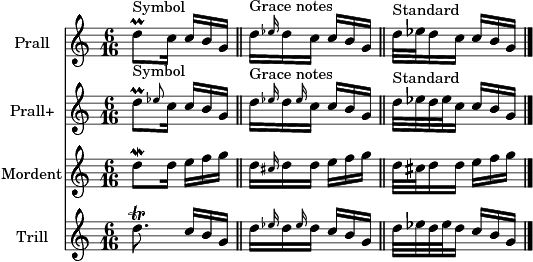
Index Introduction Background Definitions Setting Technique Harmony Bass Drills Scores References
This page describes the ornamental, anatomical and instrumental terminology used in the tutorial.
Bulgarian ornaments are built by inserting grace notes between the pulse 16ths of a traditional melody. Four ornaments are used frequently enough to warrant names and special symbols:
To a first approximation, graces and their preceding pulse 16ths are played as 32nds. In this way, the adjusted "pulse 16ths" continue to maintain the melodic pulse. A more involved discussion of ornament timing will follow in "Setting a tune". The pitch upon which the ornament is placed is referred to as the base of the ornament. Notes other than the base are upper or lower auxillaries.
Each ornament is illustrated below, first with a symbol, second with grace notes, and finally in standard notation:

Ornaments may straddle beams or bar lines. In that case, they are notated using graces.
NEED EXAMPLE: pralls straddling beams
Ornaments normally use the chromatic half-step auxillary. When a whole-step auxillary is used, an accidental is added:

Sometimes, more distant auxillaries are used, notated with a note name above or below the ornament:

An antemordent is a variation of a mordent with altered timing. The first two notes are shifted forward in time, approximating an anticipatory grace note followed by two step-wise rising pulse 16ths. However, the actual shift is not that extreme, and so the exact nature of the timing is tricky. I notate antemordents with graces notes rather than with a special symbol. A slur connects the grace and following pulse 16ths to prevent misinterpretation of the grace's function.

A blip is an upper auxillary grace inserted between two descending pulse 16ths, or after a pulse 16th followed by a rest.

The fingers of the hand are numbered 1 to 5 (with the thumb being 1) in the conventional manner for keyboard instruments.
NEED TO DESCRIBE ORNAMENT FINGERING HERE
The palm here refers to the main body of the hand that supports fingers 2-5. Therefore, the hand consists of the thumb plus the palm.
The upper keyboard is the part of the keyboard with the high notes and (confusingly) the part closest to the ground. The lower keyboard is the part of the keyboard with the low notes, which is farthest from the ground. Vertical motion refers to motion perpendicular to the plane of the keyboard, while horizontal motion refers to motion up or down the keyboard.
The hand angles right when the fingers are further up keyboard than the wrist, and angles left when the fingers are further down keyboard thant the wrist.
The hand tils left when the thumb is closer to the plane of the keyboard than the pinkie, and tilts right in the opposite case, and is neutrally tilted when in between the two. Tilt may be described relative to the keyboard (absolute tilt) or relative to the current position of the hand (relative tilt).
The wrist is raised or elevated when it is relatively farther from the plane of the keyboard, and lowered when it is closer to the plane of the keyboard.
The hand is deep in the keyboard when fingertips 2-5 naturally rest above the black keys, and shallow when the same fingertips naturally rest above the white keys. Hand insertion refers to the quality of deepness or shallowness.
The hand's attitude is the entirety of posture relative to the keyboard, including angling, tilt, elevation and insertion. The hand's position refers to the actual position up or down the keyboard in preparation for key depression.
Keyboard draft is the a key's vertical displacement from neutral position to the point where the reed sounds. A shallow draft is important for some techniques, such as white-key glides.
To designate reed combination switches, I will use the following names: clarinet means a single middle-range reed; bandoneon means a low-octave/middle-range combination with no musette; organ means a low-octave/high-octave combination with no musette.
Copyright 2013 Erik Butterworth. All rights reserved.